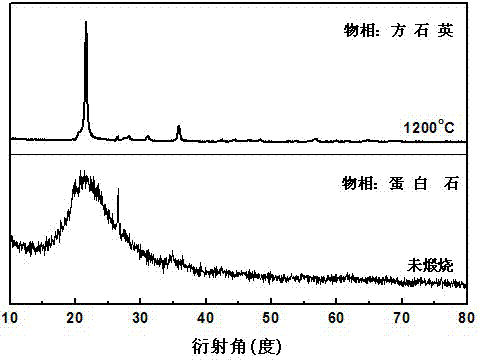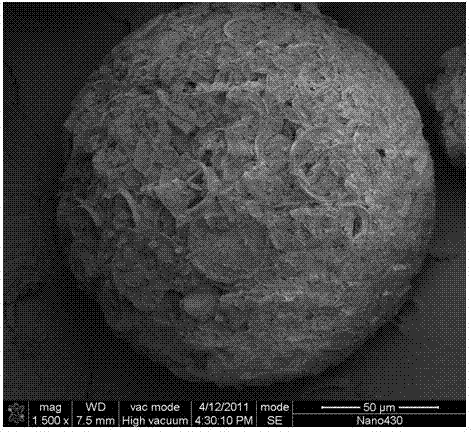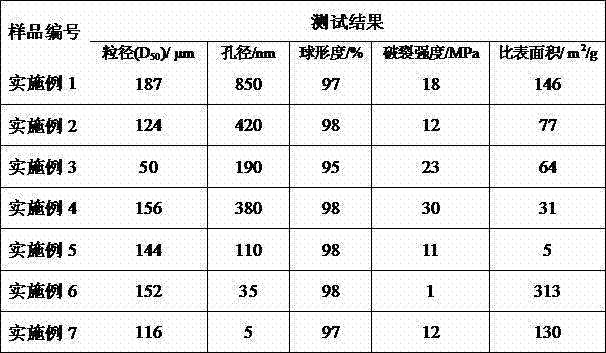Preparation method of diatomite-based porous ceramic microspheres
A technology of diatomite and porous ceramics, which is applied in the field of catalyst carrier preparation, can solve the problems of complex process, single pore size distribution, and high production cost, and achieve the effects of simple process, large specific surface area, and low production cost
- Summary
- Abstract
- Description
- Claims
- Application Information
AI Technical Summary
Problems solved by technology
Method used
Image
Examples
Embodiment 1
[0025] Weigh 200g of diatomite raw material, 0.2g of carbon powder, add 0.2g of sodium carboxymethyl cellulose, and add 250mL of water at the same time, wet ball milling, the ratio of material to ball is 1: 0.2, ball milling for 0.5h, and the slurry is passed through 250 mesh Sieve; then spray dry the slurry into balls, the spray drying process parameters are: drying air temperature 350°C, spray head speed 2000rpm, spray tower internal pressure -80Pa; the microspheres prepared by spray drying are fired at 1200°C, and Keep warm for 1 hour to form porous ceramic microspheres. The results of phase analysis before and after the calcination of the microspheres are shown in the attached figure 1 As shown, the main crystal phase of the microspheres before calcination is opal, and after calcination at 1200°C, the main crystal phase is cristobalite. attached figure 2 It is the scanning electron microscope image of microspheres after calcination. It can be seen from the figure that t...
Embodiment 2
[0027] Take the diatomite raw material of 200g, 15g calcium carbonate, add 0.3g sodium carboxymethyl cellulose and 0.2g sodium hexametaphosphate, add 160mL water simultaneously, wet method ball milling, material-ball ratio is 1: 0.5, ball milling 5h, The slurry is passed through a 250-mesh sieve; then the slurry is spray-dried into balls. The spray-drying process parameters are: drying air temperature 250°C, spray head speed 5000rpm, spray tower internal pressure -110Pa; spray-dry the prepared microspheres at 900 ℃ firing, and heat preservation 0.1h, that is, porous ceramic microspheres.
Embodiment 3
[0029] Weigh 200g of diatomite raw material, 12.5g of polyethylene glycol, 40g of soluble starch, add 1g of sodium hexametaphosphate, and add 160mL of water at the same time, wet ball milling, the ratio of material to ball is 1: 2, ball milling for 10h, and the slurry is passed 250 mesh sieve; then spray dry the slurry into balls, the spray drying process parameters are: drying air temperature 250°C, spray head speed 12000rpm, spray tower internal pressure -200Pa; the microspheres prepared by spray drying are fired at 1200°C , and keep warm for 3h, that is, porous ceramic microspheres.
PUM
| Property | Measurement | Unit |
|---|---|---|
| Particle size | aaaaa | aaaaa |
Abstract
Description
Claims
Application Information
 Login to View More
Login to View More - R&D
- Intellectual Property
- Life Sciences
- Materials
- Tech Scout
- Unparalleled Data Quality
- Higher Quality Content
- 60% Fewer Hallucinations
Browse by: Latest US Patents, China's latest patents, Technical Efficacy Thesaurus, Application Domain, Technology Topic, Popular Technical Reports.
© 2025 PatSnap. All rights reserved.Legal|Privacy policy|Modern Slavery Act Transparency Statement|Sitemap|About US| Contact US: help@patsnap.com



